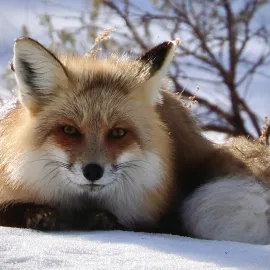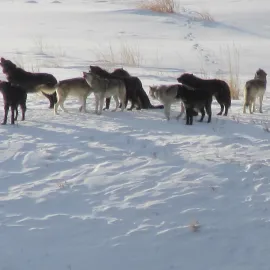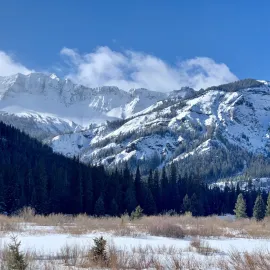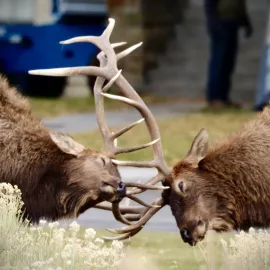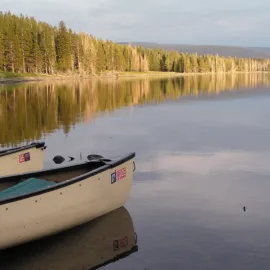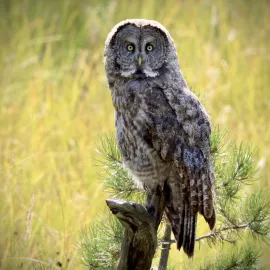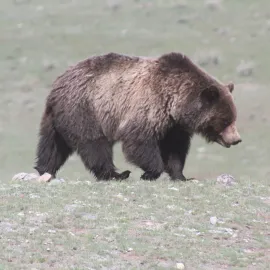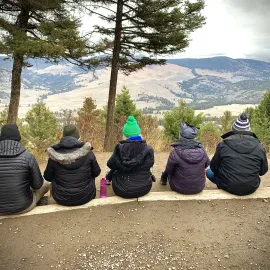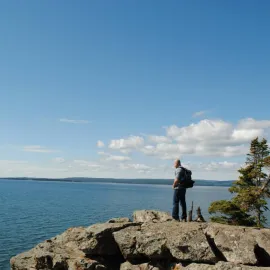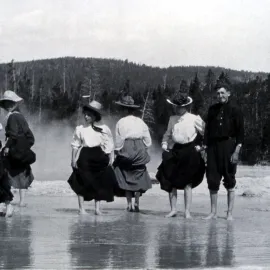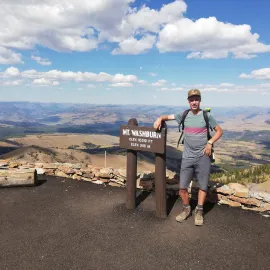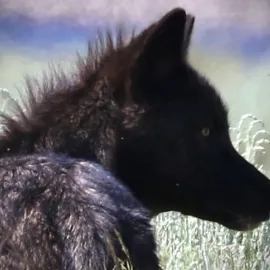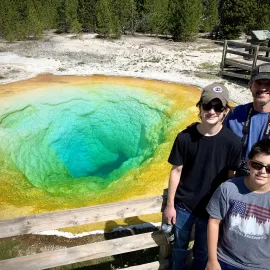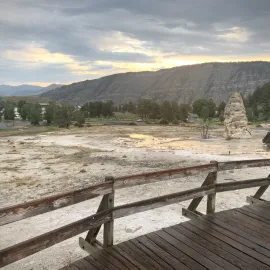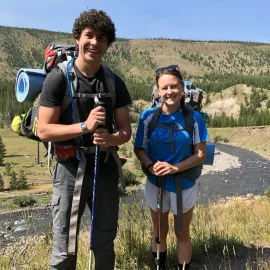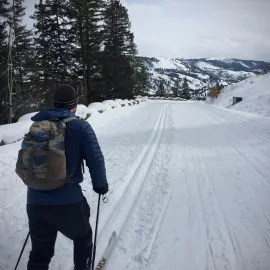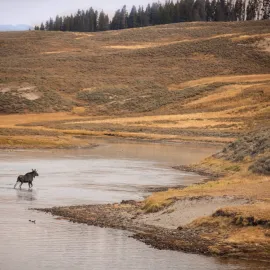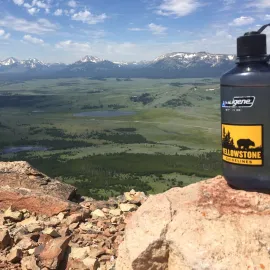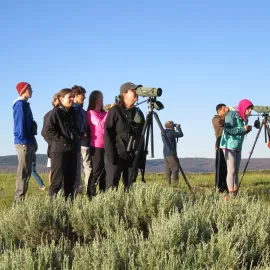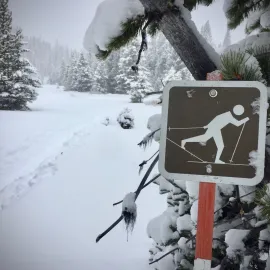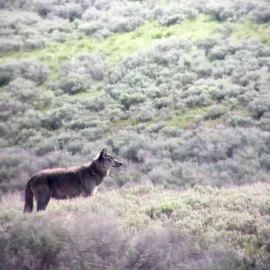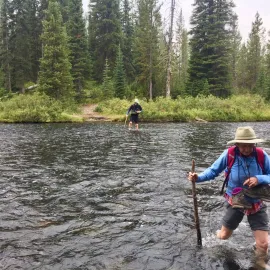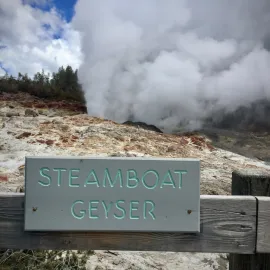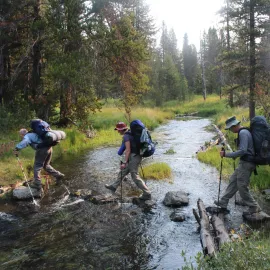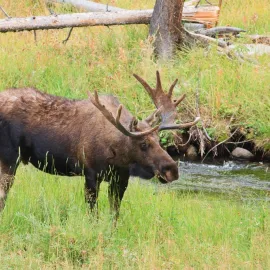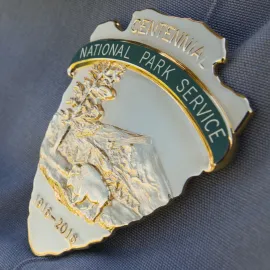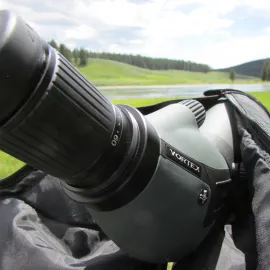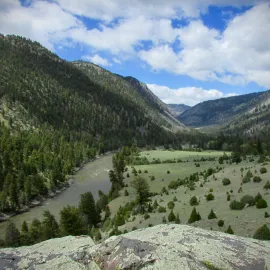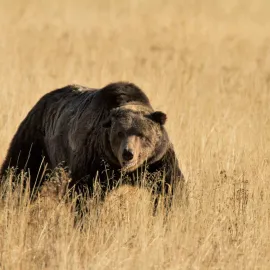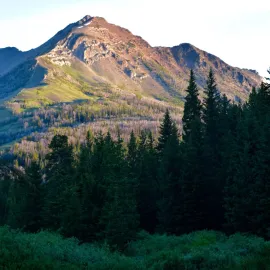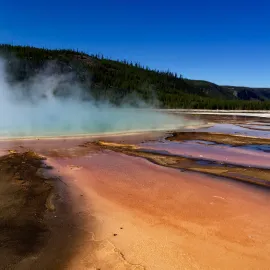Skiing Mammoth Hot Springs in Yellowstone
Mammoth Hot Springs is located in the north of Yellowstone National Park. Mammoth Hot Springs is open-year round and has incredible Nordic skiing opportunities from December to March. Cross-country skiing in Yellowstone is a great way to explore the park during the winter season. Enjoy the peace and solitude that comes with x-c skiing, take advantage of the snowy paradise that is the northern Rockies, and go explore Yellowstone in winter! Skiing is the perfect adventure for your next winter vacation in Yellowstone.
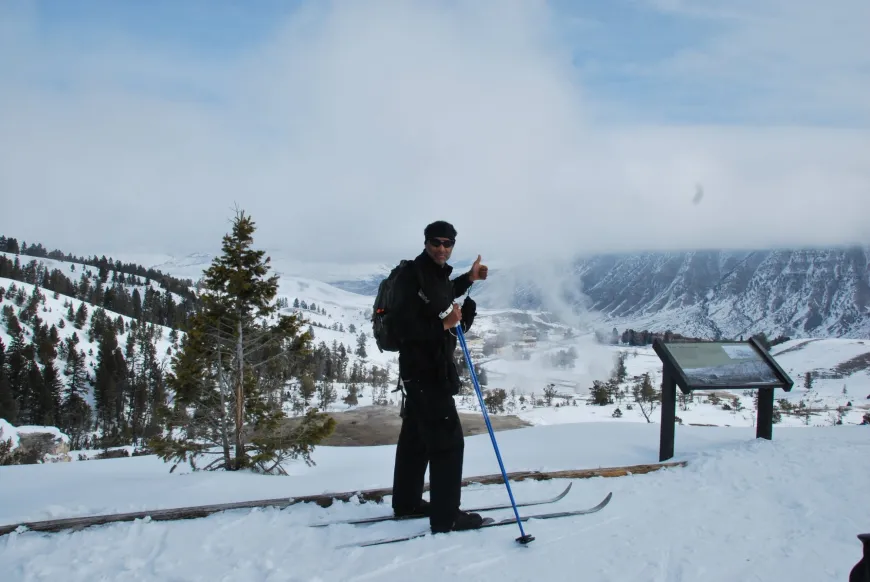
Ski Trails and Routes for Mammoth Hot Springs in Yellowstone:
Upper Terrace Loop Ski Trail
Mammoth Hot Springs are the largest travertine terraces in the world. Mammoth is called “Mammoth”, due to its enormous size. The Upper Terrace Loop of Mammoth circles the top portion of this unique geological feature. During the summer months, the loop is a one-way drive for visitors. For the winter season in Yellowstone, the Upper Terrace Loop is turned into a great cross-country ski route.
BOOK A SKI TRIP IN YELLOWSTONE
The trail starts at the parking lot at the Upper Terraces above Mammoth. We recommended taking the trail to the left and skiing the loop in a clockwise direction. The first major spring is Angel Terrace. Angel Terrace has become very active in recent months. As of December 2020, Angel Terrace is one of the most active springs in Mammoth. The first portion of the trail is a moderate climb. As you ascend, look for the spur trail to the Snow Pass Ski Trail. Continue past the intersection of Snow Pass and onto Orange Mound Spring. Orange Mound Spring is a huge hot spring formation that is only visible on skis or snowshoes in the winter. After Orange Mound Spring, the trail descends to the north and offers great views of the town of Mammoth or Fort Yellowstone. The town of Mammoth Hot Springs is actually an old military base, known as Fort Yellowstone. Continue along the ski track and back to the starting point. If feeling motivated, take your skis off and walk down to the overlook of Canary Springs.
Length: 1.5 miles (2.4 KM)
Rated: Easiest to Difficult
Elevation: Approximately 200 feet (61 M)
Other: For a longer day be sure to connect the Snow Pass Trail from the Upper Terraces
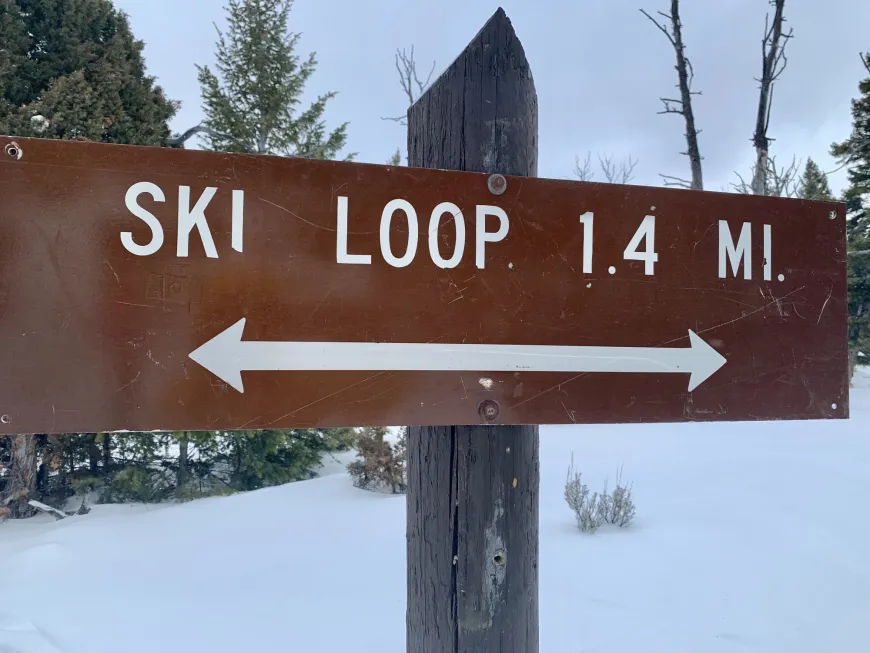
Snow Pass Trail in Yellowstone
The Snow Pass Trail in Yellowstone is the route that takes you from Mammoth to the beginning of Swan Lake Flats. The Snow Pass Trail ascends 700 feet in 1.5 miles through a dense forest until it reaches the flats. At the top, enjoy the mountainous views of the Gallatin Range. The upper-portion of the trail is mellow and easy, following Glenn Creek for about 2.2 miles and back to the main road. To return back to the car, you can either retrace your tracks down Snow Pass, take the main-road down to Mammoth, or ski the Bunsen Peak Trail down the hill. Please be cautious when skiing down the Snow Pass Trail. There are sharp and icy corners with steep drop offs. When in doubt, take your skis off and walk down!
There are multiple starting locations for the Snow Pass Trail. You can take the Upper Terrace Loop Trail or park at the top of the Upper Terrace Parking Lot, ski up the main road, and connect with the trail on your right.
Snow Pass Trail Info:
Length: 4.2 miles (6.76 KM)
Rated: Easiest to Difficult
Elevation: 700 ft (213 M)
Other: Can be steep and icy. Use caution on the descents.
Bunsen Peak Road Trail
The elevation of Bunsen Peak in Yellowstone is 8563 ft. Bunsen Peak was named after Robert Bunsen, a German scientist, who theorized about the functions of earth’s geothermal activity. Bunsen Peak is a popular day hike in Yellowstone and an achievable summit for many tourists. The Bunsen Peak Road Trail is a 6 mile ski trail in Yellowstone. The ski route wraps around the mountain and is best skied as a loop that connects with the main road. The bottom portion of the trail is steep, curvy, and can have ice. Be cautious if descending in this direction. The upper areas of the Bunsen Peak Road Trail are mellow and easy. The Bunsen Peak Road Trail starts below the Upper Terraces at the YCC Facility or ski the main road to the trail intersection.
Length: 6 miles (9.6 KM)
Rated: Easy to Difficult
Elevation: 1120 Feet (341 M)
Notes: The Bunsen Peak Road is also a great mountain bike ride in the summer.
Sheepeater Ski Trail
The Sheepeater Ski Trail is named after the Sheepeater Tribe that once occupied Yellowstone. The Sheepeater Tribe lived in the north of Yellowstone and primarily hunted bighorn sheep. The tribe consisted of small family groups, and is one of over twenty Native American tribes that was affiliated with the park. The Sheepeaters are just another morsel in the rich history of Yellowstone.
The Sheepeater Ski Trail starts at the Indian Creek Warming Hut. The trail begins by following the road for ½ mile to the Sheepeater Cliffs picnic area. Evidence of wickiups or shelters used by the Sheepeater Tribe have been discovered along the basalt cliffs in the area. Continue on the trail through a steady mix of forest and meadows with consistent views of the Gallatin Mountains and the Gardiner River Canyon. The trail connects to the Bunsen Peak Trail. Return to Mammoth via the Bunsen Peak Trail (1.6 Miles), ski the main road, or double-back to the hut and arrange for a shuttle.
Sheep Eater Ski Trail Info:
Length: 5 miles (8 KM)
Rated: Easy to Medium
Elevation: 60 feet
Other: Connect to the Bunsen Peak Trail for a longer adventure.
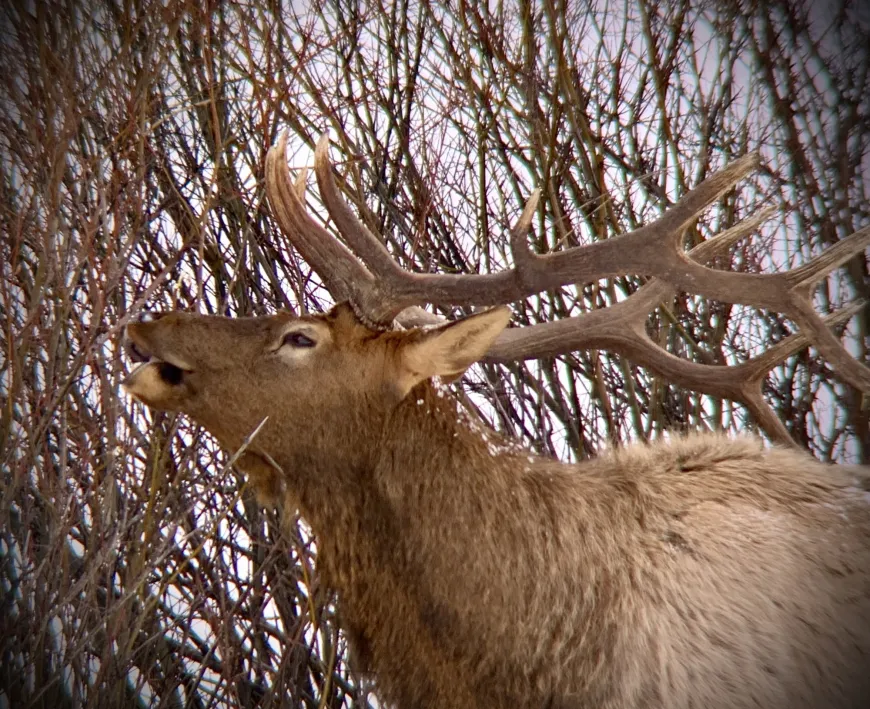
Bighorn Ski Loop
The Bighorn Ski Loop originates at the Indian Creek Hut. Begin on the Indian Creek Loop for approximately 1 mile. Look for the trail signs/markers and continue west on the Bighorn Ski Loop. There are no shortages of good views and amazing scenery on the Bighorn Ski Loop. The trail navigates a series of small foothills and rolling terrain at the base of the Gallatin Mountains. Make sure to take some photos of the Gallatin Mountains and “Gardiner’s Hole”. Gardiner’s Hole is a small valley tucked at the base of the mountains and is prime elk and grizzly bear habitat during the spring.
Once you finish skiing the Bighorn Loop, retrace your tracks to the Indian Creek Hut. You can save some time by taking the cut off trail and proceeding directly back to the hut. Always be on the lookout for wildlife and keep a safe distance. Wintering bison can be in the area.
Bighorn Ski Loop Info:
Length: 5.5 miles (8.8 KM)
Rated: Easy to Difficult
Elevation: 320 feet (98 M)
Other: A shuttle is generally needed to access the Bighorn Ski Loop.
Indian Creek Loop
The Indian Creek Loop Trail is an easy ski trail in Yellowstone. The Indian Creek Loop Trail starts at the Indian Creek Hut. Follow the road to the Indian Creek Campground. In about a ½ mile, turn left into the forest. The trail is generally mellow, with a mix of open meadows and forest, and on and off views of the Gallatin Mountains. Follow the trail to an old wagon road and back to the hut.
Indian Creek Loop Info:
Length: 2.2 miles (3.5 KM)
Rated: Easy
Elevation: Minimal
Other: A shuttle is generally needed to access the Indian Creek Loop and Indian Creek Hut.
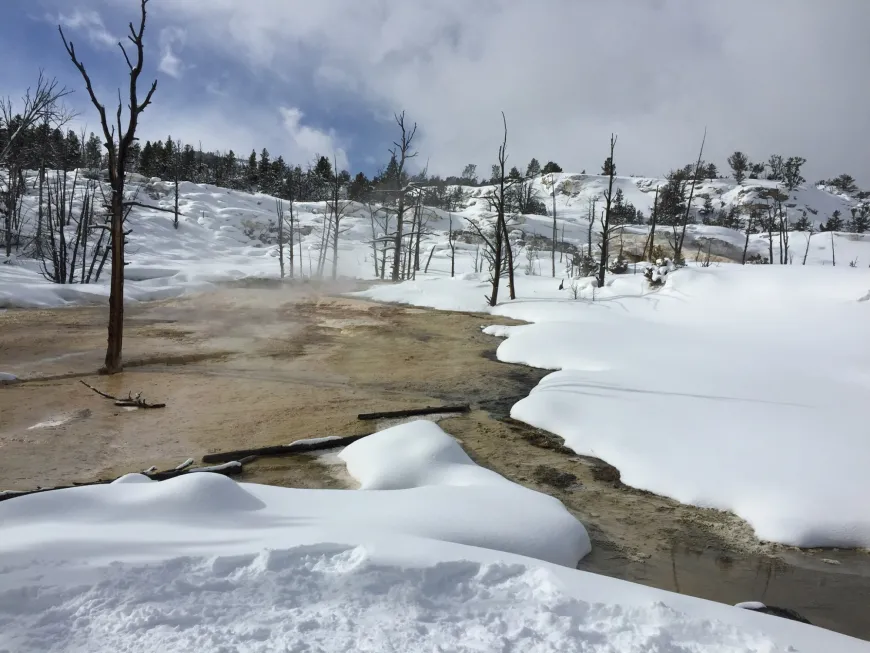
Yellowstone Trail Information:
Here is a downloadable map of the Mammoth Hot Springs ski trails…media/documents/pdf/ski-map-of-mammoth-hot-springs-in-yellowstone.pdf
For current or up to date trail information, please contact the Bear Den Ski Shop or Albright Visitor Center. Both are located in Mammoth Hot Springs. The Bear Den offers ski rentals and grooming information. Ski rentals can also be found in Gardiner, MT or Livingston, MT.
All trail ratings are by the National Park Service and specific to trails in Yellowstone.
Notes about Winter Travel
- Yellowstone’s north entrance by Gardiner, Montana is the best way to access the ski trails at Mammoth Hot Springs. The north entrance is open year-round!!! The official winter season typically starts in December 15 and ends in March (depending on snow levels).
- Winter weather in Yellowstone is extreme. Temperatures can vary from just above freezing (32 F) to nighttime lows of -30 F. Please be prepared and have plenty of layers.
- Due to the altitude of the park and winter weather of Yellowstone, it’s very important to stay well hydrated. Make sure to bring along plenty of water and snacks while skiing. Skiing can burn lots of calories that need to be replenished.
The blog post and trail info was written by Chris Hondorf, owner and guide for Yellowstone Guidelines. Yellowstone Guidelines offers a variety of winter adventures in Yellowstone like cross-country skiing, snowshoeing, and wildlife tours. Contact us today – tours@yellowstoneguidelines.com or 406.599.2960. Hope to see you on the trail!
BOOK A WINTER TRIP IN YELLOWSTONE

